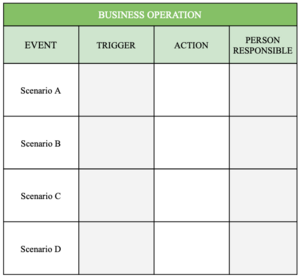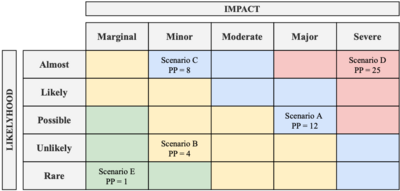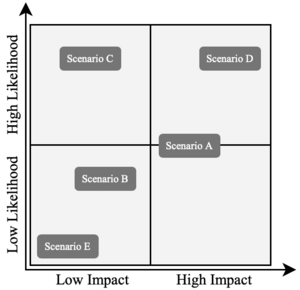Contingency plans
Abstract
What will happen if Plan A doesn't work? Uncertainty is a part of projects and cannot be avoided. There are things that we know can go wrong and things that we do not know about. The main part of the uncertainty is the anticipation of risks, both desired and undesired. The classic risk management process is risk identification, assessment, treatment, and control. Contingency plans are about how to deal with the risk.
"The purpose of treat risk is to develop options and determine actions to enhance opportunities and reduce threat to project objectives.
Risk treatment includes measures to avoid the risk, to mitigate the risk, to deflect the risk or to develop contingency plans to be used if the risk occurs".
[1]
Contingency plans are your Plan B and ask the questions "What if....?" [2]. The risk could be anything from major crises, natural disasters to more common problems.
Then there is the question of who creates these plans? Is it the top management, owner, or even the summer intern?
There is not just one way to create a contingency plan, and therefore not just one role in a company that creates such plans. The overall responsibility and management are assigned to the most relevant person and that person is responsible for consulting and informing.
Steps to take in the creation of such a plan may vary from business to business and from project to project. According to the ISO 21500 Standard, the primary inputs are risk register and project plans and the primary outputs are risk responses and change requests.
259 WORDS
Contents |
What is a Contingency Plan?
A contingency plan is about controlling possible risks that may occur before or during a project. In other words, creating a "Plan B".
Contingency plans are crucial for all projects, no matter the size and duration. There are a lot of things that can go wrong in projects and many aspects to look at. Not being prepared when and if they occur can be the undoing of projects and sometimes businesses.
Even though you create a contingency plan it is not guaranteed that you are prepared for everything that might go wrong, that depends on how well you brainstorm and how good of a team you have. How detailed the risk assessments are, should depend on the manager. Ideally, not only should the plan cover significant issues, but it should also have a plan for more common errors that could occur. That way they are handled more efficiently [3].
However, contingency plans do not only have to cover negative events, but they can also cover positive events, for example, what if your project receives more funding than planned? [2]
Creating a contingency plan does not only make you a smart project manager but also makes you more proactive rather than reactive. Then it is good to know and understand the basic steps on how to create such a plan.
217 WORDS
How To Create a Contingency Plan
The steps in creating a contingency plan differ from department to department and from project to project. However, they all have a similar base and will help with handling risk management. The steps below are a combination of the great sources under "References".
 Figure 1: Contingency Plan Template [3]
Figure 1: Contingency Plan Template [3]
1. Identify Business Operation
- What is the plan for? What will be identified? Is it the whole project or some part of it?
- Example: The supply chain of the project is a key factor therefore a detailed contingency plan is created for that part.
- Example: The whole project is broken down into small sections and that way you have a contingency plan for the whole project.
2. Identify Risks, Threats or Events
- What can go wrong? What are your week links? What else do we need to be prepared for?
- Example: Deadline not met, system failure, weather, more funding, sick employees, and so on.
3. What Will Cause the Risk or Threat to Happen?
- What triggers the scenario? What exactly will be the cause for the plan to be put into action?
- Example: You know the project will not meet the deadline do you activate the plan then or do you wait until the deadline has passed to activate it?
4. What Is the Reaction?
- Identify a strategy that will be executed in response to the event. What is the reaction if this event were to occur?
- Example:
5. Who Is Responsible For Activating the Plan?
- If an event occurs, who is it that will set the plan to action and control it?
- TIP: Try not to put a name in the contingency plan rather a job title or department. As we know people come and go within companies and projects.
284 WORDS
Additional Step
As mentioned the contingency plans are never identical, some are more detailed than others, some have a wider spread all that depends on the project and project managers.
Often there is a limited time that can be set aside for creating a contingency plan and sometimes there are too many things that have been identified as risks/events. When that happens it is good to add a step to the contingency plan. That is once the risks have been identified next step is to analyze the impact and likelihood of that event from happening and therefore give them a PP number (Potential Problem number). Many scales can be used to evaluate the impact and likelihood, however, the most common way is to enumerate them from 1-5.
- For example:
- Likelihood: Rare(1) - Unlikely(2) - Possible(3) - Likely(4) - Almost(5)
- Impact: Marginal(1) - Minor(2) - Moderate(3) - Major(4) - Severe(5)
- Example: If the event has moderate impact and likely likelihood of happening, the PP number becomes: 3*4 = 12 [4]
After creating PP numbers for the events you sort them from largest to smallest and continue the steps of creating a contingency plan. That is trigger, action, and person responsible.

In some cases, there is no need to assign PP numbers, perhaps, due to few scenarios or small projects. However, it can still be useful to visualize what events can have the most impact if they occur and how likely they are to happen. One way is to create a Likelihood vs. Impact matrix, with Likelihood on the y-axes and Impact on the x-axes, see Figure 3.

266 WORDS = 1.026 WORDS
Once the Plan Has Been Created
What happens after the plan has been created? It is very common that the plan never gets used. Why is that? There are many factors that can contribute to that, the people don't get informed, the plan is never updated, the plan is too complicated, not accessible or it gets forgotten. Here are some points that might help prevent that:
- Involve the Right People
- In order for people to use the plan they need to know about it. Involve the team from the beginning, that way everyone feels included and informed.
It often happens that managers forget to inform the lower level of employees and just inform when it is time to do things. That creates low motivation and people are less likely to participate. So involve them from the beginning and get them to contribute to the plan, that way you get a wider perspective and might even get a result you did not even consider.
- Update the Plan
- Another common thing is when it has been created it never gets updated. Therefore, it might not be relevant after some time.
- Make it Understandable
- Store it Securely
Introduce it to the team once it has been created, who knows someone you didn't even consider might have an idea or give useful information. Make sure to revisit your plan frequently or as frequent as needed depending on the length of the project and complexity of it. Is there something that is not relevant anymore, got a better solution or new risk? Also keep the plan simple, try not to use words or abbreviation not everyone is familiar with, and keep the text as much to the point as it can be (otherwise people might not read it) Then there is the question of who is responsible for the plan? Most of the time it is the project manager, however that does not need to be the case. It can be any person that has a good overview and knows what the project is about...
Useful Tools
ow do you set up you contingency plan? There are many different ways on how to construct a good contingency plan. A common way is to use excel or similar software. - Mynd excel - - Mynd annað -
Gannt Charts have sometimes been used in then they can show in case scenario x happens the project will be delayed y
Models and forms to use: Asana - asana.com - Búa til í kringum dæmið Create dash boards
Regerences
- ↑ Danish Standards Foundation. (2012). DS/ISO 21500. Danish Standards Foundation. 26.
- ↑ 2.0 2.1 Kris Huges (2018). How to Make a Contingency Plan. https://www.projectmanager.com/blog/contingency-plan. Visited: 09/02/2021.
- ↑ 3.0 3.1 The Mind Tool Content Team (2016). Contingency Planning.https://www.mindtools.com/pages/article/newLDR_51.htm. Visited: 09/02/2021.
- ↑ Joe Tidd and John Bessant (2019). Potential problem analysis. http://www.innovation-portal.info/wp-content/uploads/Potential-problem-analysis.pdf. Visited: 19/02/2021.
- ↑ Blake Bassett (2020). When You Don’t Know What to Do, Solve a Problem. https://medium.com/swlh/when-you-dont-know-what-to-do-solve-a-problem-3f9116d8b161. Visited: 17/02/2021.
- ↑ Amanda Athuraliya (2020). The Easy Guide to Creating a Business Contingency Plan. https://creately.com/blog/business/business-contingency-plan-templates/. Visited: 19/02/2021.
